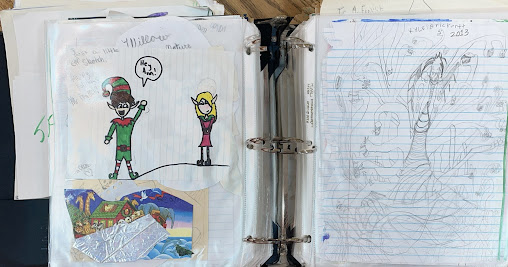Assessment in Art at SCE
Many (new) art teachers and those schooled in Discipline Based Art Education (DBAE) ask me this question: How do you grade art? My answer is this: Why should I grade art? What is the purpose of a grade? Is it to have a concrete symbol in a book so that when an administrator wants to see your grade book, you'll have something there? Or is is a way to justify to yourself that what you are doing is meaningful? Or, is it a way to control students to act in a certain way? I see too many teachers use grading in art as a weapon to hold over a student until a desired behavior is displayed. YIKES!!! Seriously!
-
Come to art with an idea (or the willingness to explore and experiment with tools and materials in order to generate an idea)
-
Set up a work area with chosen tools and materials
-
Use available references and resources to support and expand ideas and processes
-
Use and care for tools, materials
-
Access digital tools and resources appropriately
-
Engage and persist with selected ideas, techniques, and processes
-
Work as an artist in a cooperative, community studio setting
-
Clean up workspace and care for the studio
-
Reflect on work done and consider possible next steps
-
Actively participate in classroom discussions and lessons about art and the art world
On any given week or rotation I will assess kids using observation of students working in the studio. I look at what they are working on, who they are working with, what stage in the creative process are they in, If I need more information, I can talk to them about their work.
At the end of class, we have share time where I invite students to talk about their work. Sometimes, Ill ask them what obstacles they overcame to finish the piece? or What new techniques or skill have they been working on.
-
Self-reflection and self-assessment - Students compare their work and process to 8 Studio Thinking Habits used by practicing artists.
-
Artist Statements - students write narrative reflections for completed artwork
-
Art sharing through peer-share, school-wide display, individual and group critique, “pop-up” art shows
-
Individual consultations
-
My observations of students at work in the studio
-
Final reflective portfolio and summary 4th Grade
- Come to art with an idea (or the willingness to explore and experiment with tools and materials in order to generate an idea)
- Set up a work area with chosen tools and materials
- Use available references and resources to support and expand ideas and processes
- Use and care for tools, materials
- Access digital tools and resources appropriately
- Engage and persist with selected ideas, techniques, and processes
- Work as an artist in a cooperative, community studio setting
- Clean up workspace and care for the studio
- Reflect on work done and consider possible next steps
- Actively participate in classroom discussions and lessons about art and the art world
On any given week or rotation I will assess kids using observation of students working in the studio. I look at what they are working on, who they are working with, what stage in the creative process are they in, If I need more information, I can talk to them about their work.
At the end of class, we have share time where I invite students to talk about their work. Sometimes, Ill ask them what obstacles they overcame to finish the piece? or What new techniques or skill have they been working on.
At the end of class, we have share time where I invite students to talk about their work. Sometimes, Ill ask them what obstacles they overcame to finish the piece? or What new techniques or skill have they been working on.
- Self-reflection and self-assessment - Students compare their work and process to 8 Studio Thinking Habits used by practicing artists.
- Artist Statements - students write narrative reflections for completed artwork
- Art sharing through peer-share, school-wide display, individual and group critique, “pop-up” art shows
- Individual consultations
- My observations of students at work in the studio
- Final reflective portfolio and summary 4th Grade



Comments
Post a Comment